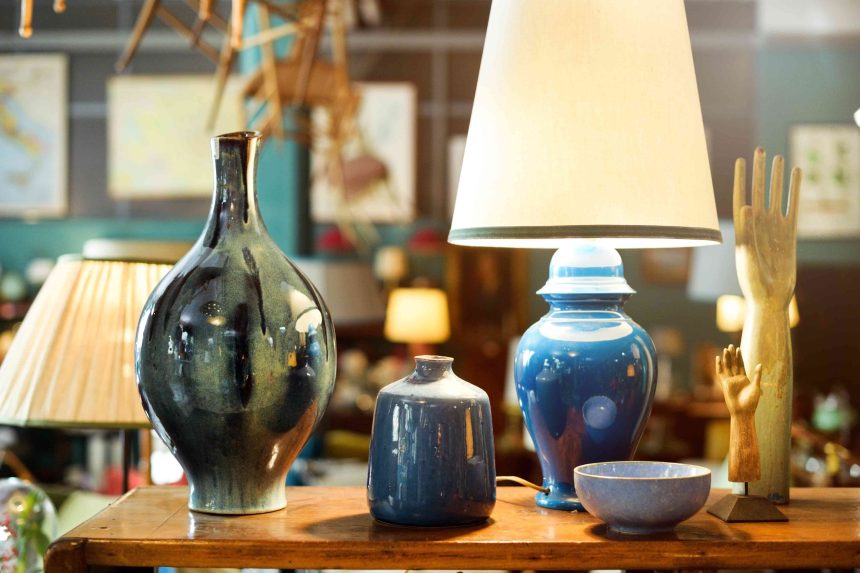In a time when you can decorate your home with a few swipes or clicks, thrift shopping can seem like an antiquated endeavor. (The amount of time and research is at odds with today’s emphasis on instant gratification.) But if you’re looking for beautiful, budget-friendly items that speak to your unique sense of style, slow and steady wins the race.
Unlike antiquing—which is similar in theory but different in practice—thrift shopping celebrates the art of buying secondhand. “When you go thrift shopping, you may come across an amazing French antique that’s 100 years old, a vintage piece from the ’80s, or a recently manufactured item from West Elm at a major discount,” says Paige Kontrafouris, an interior designer and stylist. “It’s an open book of what you can find, whereas you know that an antique store has very old pieces and collectibles from the start.”
Anyone can go thrift shopping, but separating your new treasure from another person’s trash can be easier said than done. To help, we asked designers to share their top tips for thrift shopping like a pro.
Make a Plan—and Stick to It
Unlike shopping online or at a typical brick-and-mortar storefront, thrift shopping has its mysteries. While it is important to keep an open mind, Enrique Crespo, CEO and founder of Crespo Design Group, encourages you to make a plan for your shopping excursion. “While impulse buying can be a total thrill in the moment, remember that those price tags could haunt you later,” he says.
Bring a List
Thrift stores can be packed to the brim with items—it helps to have a list of exactly what you’re looking for. “Create a shopping list of specific items you’re seeking before entering the thrift store,” says Julie Leffell, an interiors photographer. “Begin your search by heading straight to those sections. Once you’ve checked off your targeted items—or if you can’t find them—explore the rest of the store. Hidden treasures often lurk in unexpected corners, waiting to be discovered.”
Kontrafouris keeps an ongoing list of pieces at all times. “When I’m out shopping, I’ll constantly reference it,” she says. “One day I might really be looking for a side table and not find it, but later in the week, I might be out again looking for something else and see the perfect table I was searching for a week ago.”
Write Down Measurements—and Bring a Measuring Tape
If your list includes furniture, be sure to bring your ideal measurements along with you, too. “For items like furniture, artwork, or decor, come equipped with knowledge of the measurements that will work best in your space. I like to keep a note on my phone with the maximum and minimum measurements that work,” says Leffell. “Carry a tape measure in your bag to swiftly confirm whether a find aligns with your requirements. This proactive approach ensures you make informed decisions and avoid purchasing items that won’t fit.”
Start Small
With so little time and so many items, walking into a thrift store can feel understandably overwhelming. If you’re new to this endeavor, you might want to start with some smaller pieces. “Searching for smaller items like décor is a great way to add some interest to your coffee table or bookshelf without having to commit to larger pieces,” says Laura Chappetto, interior designer and founder of Element Design Network.
While Crespo does shop for furniture at thrift stores, he also looks out for smaller pieces like glassware and home accents. “There are usually a few hidden gems within these categories,” he says.
Shop Local and in Person
Though the internet is packed with wonderful ways to thrift shop from the comfort of your couch, Kontrafouris and Crespo agree that the hunt is best done in person. In fact, many of the best vendors are hiding in plain sight. “Some of the best places to thrift are sometimes the most inconspicuous,” Crespo says. “Markets—while they do not always contain antique or designer pieces—have some of the most gorgeous items to browse and pick up.”
Make your first stop at your local flea market. Not only is it a treasure trove for amazing finds, but you’ll also be able to peruse multiple vendors, making it possible to find something that’ll fit your budget or price point.
Do Your Research
The best—and, well, sometimes worst—part of thrift shopping is that you truly never know what you’re going to find. So, how do you know if a piece is valuable or high quality? You might need to do your homework beforehand. “If you’re looking for a chic, valuable piece, you have to understand which materials are of genuine quality and are undeniably authentic when you see it,” says Crespo.
Understand Markers and Signs—or Research in Real-Time
What are burgeoning thrift shoppers to do if they fall in love with a piece and haven’t done their research ahead of time? Keep your eyes peeled for signs such as unique markings, countries of origin, and confirmation that you’re dealing with high-quality materials like wood or porcelain.
And if you’re really stumped, head online. “I love using the Google Lens app to quickly scan the internet for an item if it’s not something I have a ton of knowledge on,” Kontrafouris says. “It also helps to research items you like in your free time, so you can learn the unique details about them and know what to keep an eye out for.”
Visit Your Favorite Thrift Stores Often
You never know what you’re going to find and inventory can change often, so it helps to become a regular at your favorite places. “Make it a habit to revisit thrift stores regularly. The inventory is constantly evolving, with new and unique items making their way onto the shelves regularly,” says Leffell. “By checking back often, you increase your chances of stumbling upon that one-of-a-kind find you’ve been dreaming of.”







